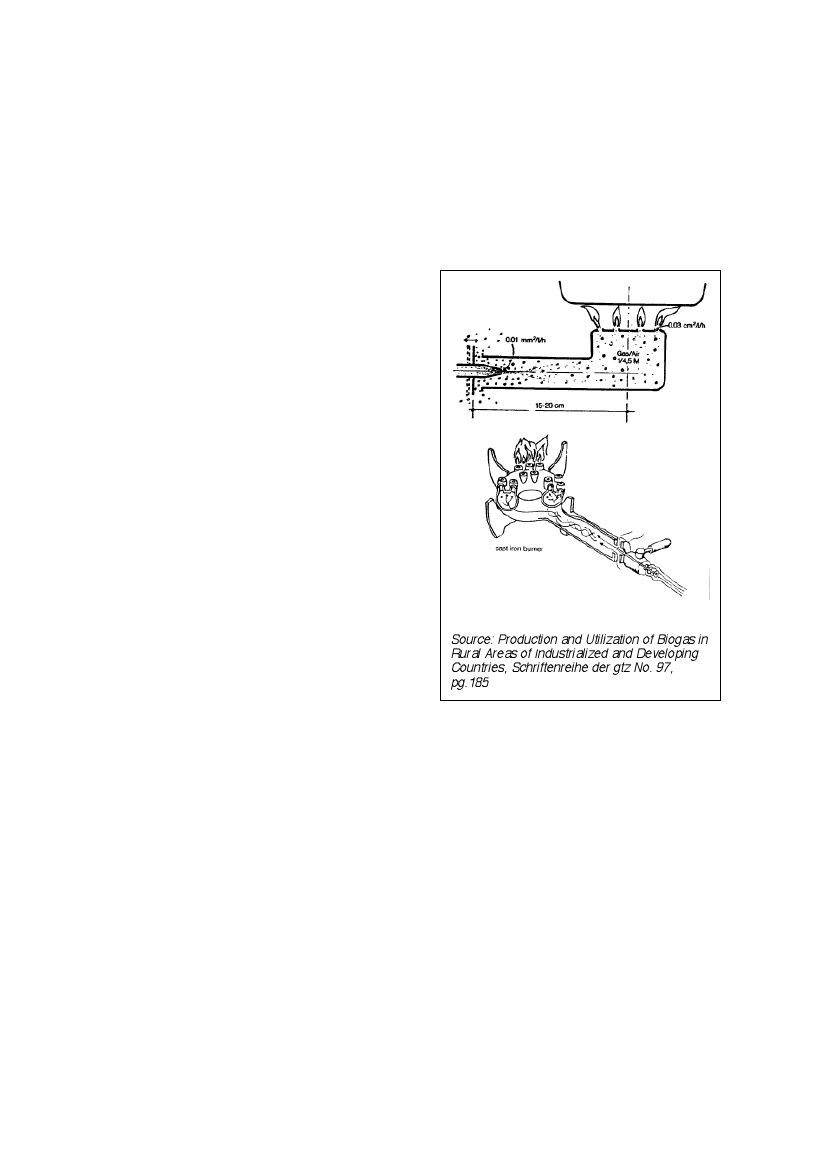
Avoiding de-sulfurization altogether is possible, if only stainless steel appliances are used.
But even if they are available, their costs are prohibitive for small scale users.
Reduction of the carbon-dioxide content
The reduction of the carbon-dioxide content is complicated and expensive. In principle,
carbon-dioxide can be removed by absorption onto lime milk, but that practice produces
"seas" of lime paste and must therefore be ruled out, particularly in connection with large-
scale plants, for which only high-tech processes like micro-screening are worthy of
consideration. CO2 "scrubbing" is rarely advisable, except in order to increase the individual
bottling capacity for high-pressure storage.
Biogas burners
In developing countries, the main prerequisite
of biogas utilization is the availability of
specially designed biogas burners or modified
consumer appliances. The relatively large
differences in gas quality from different plants,
and even from one and the same plant (gas
pressure, temperature, caloric value, etc.)
must be given due consideration.
The heart of most gas appliances is a biogas
burner. In most cases, atmospheric-type
burners operating on premixed air/gas fuel are
preferable. Due to complex conditions of flow
and reaction kinetics, gas burners defy
precise calculation, so that the final design
and adjustments must be arrived at
experimentally. Compared to other gases,
biogas needs less air for combustion.
Therefore, conventional gas appliances need
larger gas jets when they are used for biogas
combustion. About 5.7 liters of air are required
for the complete combustion of one liter of
biogas, while for butane 30.9 liters and for
propane 23.8 liters are required.
Figure 45: Schematic diagram of a gas
burner
Source: Production and Utilization of Biogas in
Rural Areas of Industrialized and Developing
Countries, Schriftenreihe der gtz No. 97,
pg.185
The modification and adaptation of commercial-type burners is an experimental matter. With
regard to butane and propane burners, i.e. the most readily available types, the following
pointers are offered:
• Butane/propane gas has up to three times the caloric value of biogas and almost
twice its flame-propagation rate.
• Conversion to biogas always results in lower performance values.
Practical modification measures include:
• expanding the injector cross section by factor 2-4 in order to increase the flow of gas;
• modifying the combustion-air supply, particularly if a combustion-air controller is
provided;
• increasing the size of the jet openings (avoid if possible).
The aim of all such measures is to obtain a stable, compact, slightly bluish flame.
Efficiency
The calorific efficiency of using biogas is 55% in stoves, 24% in engines, but only 3% in
lamps. A biogas lamp is only half as efficient as a kerosene lamp. The most efficient way of
using biogas is in a heat-power combination where 88% efficiency can be reached. But this
is only valid for larger installations and under the condition that the exhaust heat is used
77